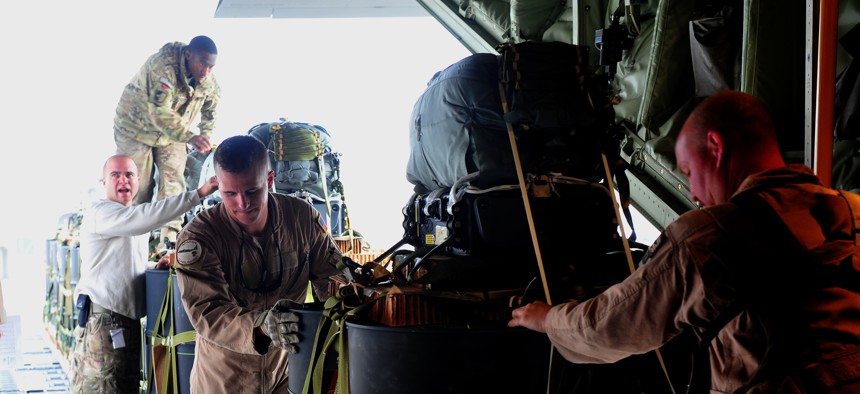
Air Force and Army personnel use a K-loader to load the Joint Precision Air Drop system bundles onto a C-130J Hercules, Bagram AF, Afghanistan, Nov. 27, 2011. TYLER PLACIE / US AIR FORCE
Army Testing Robo-Parachutes That Don’t Need GPS
The military needs what goes up to come down without the global positioning system.
Military cargo-drops to places like forward operating bases in Afghanistan need to go off perfectly. When they don’t, soliders have to expose themselves to dangerous fire to retrieve the package that missed its target. But there are a lot of things that can get in the way of a precision drop. Increasingly, that includes insecurities in the global position system.
The Army is testing a new joint precision airdrop system, or JPADS. The ultimate goal is a system that can be fitted to cargo that the military can drop from 25,000 feet and from as far away as 20 miles to a specified location, all without GPS. So far, the Army has tested the new JPADS at 10,000 feet in Arizona and they’re planning on tests at higher ranges to confirm that it will work as expected.
The system uses an aerial guidance unit, or AGU: essentially, a box containing a set of motors that manipulate and steer the parafoil, and a computer. A camera sits underneath.
Defense contractor Draper makes the software on the unit, which uses data from the camera to understand where it is and manipulate the parachute to go where it wants to go.
“The payloads were dropped from planes, and then JPADS immediately determined their own location by comparing terrain features spotted using optical sensors with commercial satellite imagery of the area,” Draper said in a press release.
“We’re programming a computer to do what we all do on a daily basis. A lot of us navigate by image recognition. If I’m driving home and I recognize the blue house, I know where I am relative to my destination because I’m familiar with what it looks like and can distinguish it from other blue houses,” said Chris Bessette, head of the JPADS program at Draper.
The newest capability -- determining position without any GPS -- has been in development for about nine months, but Draper has been working on vision-based navigation for about three years. “The challenge is both getting algorithms to run fast enough and being able to handle large uncertainty in your initial guess at vehicle state,” said Bessette.
The Army began developing the GPS-reliant JPADS program in 1993 and dropping them out of C-130s in Afghanistan in 2006.
The testing of a GPS-free version of JPADS is yet another example of efforts to develop alternatives to satellite guidance. “GPS is very expensive to launch and operate,” Defense Secretary Ash Carter said during an April 24 podcast from Silicon Valley, according to National Defense magazine. The global positioning system, he said, “makes us vulnerable to attacks, it is impossible to use in the valleys of Afghanistan or in a big city [where signals are blocked], or in places where the signal is poor.”
“At DoD, we worry about enemies jamming GPS signals.” Army Maj. Christopher Brown, who helps run the service’s efforts in position, navigation and timing, or PNT, told C4ISR & Networks last year. “Threats to military GPS have evolved and improved at a rapid pace — from a proliferation of small-scale commercial jamming devices that can readily be purchased on eBay to large-scale military anti-access/area-denial (A2/AD) capabilities.”
The Defense Advanced Research Projects Agency, or DARPA, is working on a variety of PNT efforts to free the military from its reliance on increasingly insecure location signals and expensive satellites. They’re working on new tech that uses everything from pulsed lasers to atomic clocks.
Once it proves its ability to escort military cargo safely to the ground, Bessette believes, Draper’s JPAD tech could find its way into self-driving cars and other aerospace applications.
“For example, drones will likely leverage the technology once it matures,” he said.




